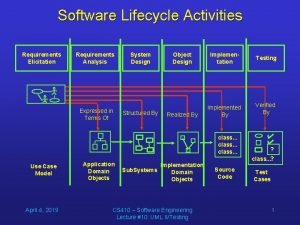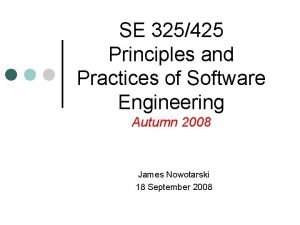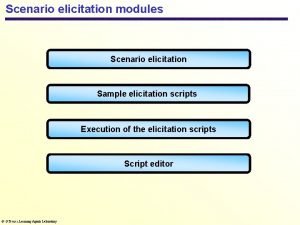Assignment 1 Requirements Elicitation and Documentation Shuai Wang






![Exercise 2 - Design class List <E>{ E[] elems; int len; boolean shared; List(int Exercise 2 - Design class List <E>{ E[] elems; int len; boolean shared; List(int](https://slidetodoc.com/presentation_image_h2/a43366f94b5d89ee916ea187d7bc9b7d/image-7.jpg)
![Exercise 2 - Design class List <E>{ E[] elems; int len; boolean shared; Question: Exercise 2 - Design class List <E>{ E[] elems; int len; boolean shared; Question:](https://slidetodoc.com/presentation_image_h2/a43366f94b5d89ee916ea187d7bc9b7d/image-8.jpg)





- Slides: 13

Assignment 1 - Requirements Elicitation and Documentation Shuai Wang shuai. wang@inf. ethz. ch

Schedule • Three hours session (tentatively decide in this way): • Some tutorial and Q&A on the first assignment • Q&A (if needed) for the second assignment • Q&A (if needed) for the group project. • Can we put all the team members into one exercise session? • Not possible for the whole class, sorry. • Contact TAs in case you have any questions or want to make any changes to the grouping and exercise session ASAP. • We are collecting and maintaining an internal list of all the grouping info. And will update online late this week, after finishing all the exercise sessions. • Anyone knows the following students? • Manuela Fischer • Hao Wu

Exercise 1 - Design and Documentation public class Node{ public Node () {. . . } public class Edge{. . . } public class STGraph{ List <Edge> edges; Passing the source and the target as arguments Question: why this design decision makes sense? Node source; Node target; public STGraph(Node source, Node target){ this. source = source; Using a setter method for modifying them afterwards this. target = target; this. edges = new Array. List <Edge>(); } public void set. ST(Node source , Node target){ this. source = source; But no free lunch! • Is this thread-safe? this. target = target; } public void add. Edge(Edge e){ edges. add(e); } public List <Node> shortest. Path () {. . . } } Answer: only if we would rarely modify source and the target

Exercise 1 - Design and Documentation public class Node{ public Node () {. . . }. . . Question: does the shortest Answer: of course no; only if the source and target are connected. path always exist? } public class Edge{. . . } public class STGraph{ List <Edge> edges; Node source; Node target; public STGraph(Node source, Node target){ this. source = source; this. target = target; this. edges = new Array. List <Edge>(); } public void set. ST(Node source , Node target){ this. source = source; this. target = target; } public void add. Edge(Edge e){ edges. add(e); } public List <Node> shortest. Path () {. . . } } Question: what information Answer: specify return values should be documented for thisregarding different cases. • What if they are not connected? function? • What if source is identical to target? • Exception or null? • Algorithm? • . . .

Exercise 1 - Design and Documentation public class Node{ public Node () {. . . }. . . Question: how to make this function more efficient? } Answer: cache the results. public class Edge{. . . } public class STGraph{ List <Node> shortest. Path (){ if(sp == null && are. Connected. ST()){ List <Edge> edges; sp = compute. Shortest. Path(); Node source; Node target; } public STGraph(Node source, Node target){ this. source = source; this. target = target; this. edges = new Array. List <Edge>(); } public void set. ST(Node source , Node target){ this. source = source; this. target = target; } public void add. Edge(Edge e){ edges. add(e); } public List <Node> shortest. Path () {. . . } } return sp; } are. Connected. ST: BFS shortest. Path: much more complicated? Dijkstra algo. ?

Exercise 1 - Design and Documentation public class Node{ public Node () {. . . } public class Edge{. . . Question: How does this design influence the client-visible documentation? Answer: no, OO design usually treats methods as black boxs. } public class STGraph{ List <Edge> edges; Node source; Node target; public STGraph(Node source, Node target){ this. source = source; Question: Are there alternative designs that achieve comparable results? Answer: a more “eager” way of doing so. • Any fundamental difference? this. target = target; this. edges = new Array. List <Edge>(); } public void set. ST(Node source , Node target){ this. source = source; this. target = target; } public void add. Edge(Edge e){ edges. add(e); } public List <Node> shortest. Path () {. . . } } Extension: cache the intermediate computation results?
![Exercise 2 Design class List E E elems int len boolean shared Listint Exercise 2 - Design class List <E>{ E[] elems; int len; boolean shared; List(int](https://slidetodoc.com/presentation_image_h2/a43366f94b5d89ee916ea187d7bc9b7d/image-7.jpg)
Exercise 2 - Design class List <E>{ E[] elems; int len; boolean shared; List(int l){ Question: a scenario in which this implementation performs unnecessary cloning operations, when the set method is called. elems = (E[]) new Object[l]; len = l; shared = false; } void set(int index , E e){ Answer: List <Integer > A = new List <Integer>(3); List <Integer > B = A. take(); b. set(0, -5); a. set(1, 40); if(shared){ elems = elems. clone(); shared = false; } elems[index] = e; } List <E> take (){ shared = true; List<E> t = new List <E>(elems, len-1); t. shared = true; return t; } } A and B are not “synchronized”.
![Exercise 2 Design class List E E elems int len boolean shared Question Exercise 2 - Design class List <E>{ E[] elems; int len; boolean shared; Question:](https://slidetodoc.com/presentation_image_h2/a43366f94b5d89ee916ea187d7bc9b7d/image-8.jpg)
Exercise 2 - Design class List <E>{ E[] elems; int len; boolean shared; Question: How could you modify the implementation to eliminate this inefficiency? List(int l){ elems = (E[]) new Object[l]; len = l; Answer: sync A and B with an object on heap. shared = false; } void set(int index , E e){ if(shared){ elems = elems. clone(); shared = false; } elems[index] = e; } List <E> take (){ shared = true; List<E> t = new List <E>(elems, len-1); t. shared = true; return t; } } Extension: learn how “smart-pointer” works in C++ 11 g.

Exercise 2 - Design Question: Is your proposed solution efficient in the case in which unused objects are removed by the garbage collector? Answer: the previous implementation cannot “decrease” the counter.

Exercise 2 – Design: A Simple Implementation of Modern C++ Smart Pointers https: //codereview. stackexchange. com/questions/159804/c-smart-pointer-implementation

Exercise 3 - Requirements Elicitation No authoritative solution to this exercise, but hope it helps for you to get some senses and think further on how to effectively gather requirements. role playing Scenarios

Exercise 3 - Requirements Elicitation: Corner Cases • Q: is an online customer logged out from the system automatically when inactive? If so, after what time? • A: Yes. When the customer is inactive for 5 minutes, he/she is logged out automatically. • Q: When a new customer creates an online account, can he place his first order to a different address than to which the credit card he is paying with is registered? • A: No. This is a security measure placed in order to prevent frauds. • A: However, after the first order was placed and the flowers were delivered, the customer can change the delivery address in subsequent orders. • Q: Is there any limit on the number of orders that can be taken per day? • A: Yes. This number depends on the number of messengers the owner currently has. • Q: Is it possible to cancel an order once it has been placed? • What’s your idea?

Let us know if you have any questions or would like to discuss • Contact TAs in case you have any questions or want to make any changes to the grouping and exercise session ASAP. • We are collecting and maintaining an internal list of all the grouping info. And will update online late this week, after finishing all the exercise sessions.
 Requirements elicitation lifecycle
Requirements elicitation lifecycle Questionnaire elicitation techniques
Questionnaire elicitation techniques What is elicitation
What is elicitation Elicitation adalah
Elicitation adalah Elicitation techniques
Elicitation techniques Prototyping elicitation technique
Prototyping elicitation technique Inception in requirement engineering
Inception in requirement engineering Numerical assignment
Numerical assignment Elicitation meaning
Elicitation meaning Internal audit documentation requirements
Internal audit documentation requirements Middle tier acquisition
Middle tier acquisition Wang peng and li you
Wang peng and li you User and technical documentation
User and technical documentation Differences between law and ethics
Differences between law and ethics
























